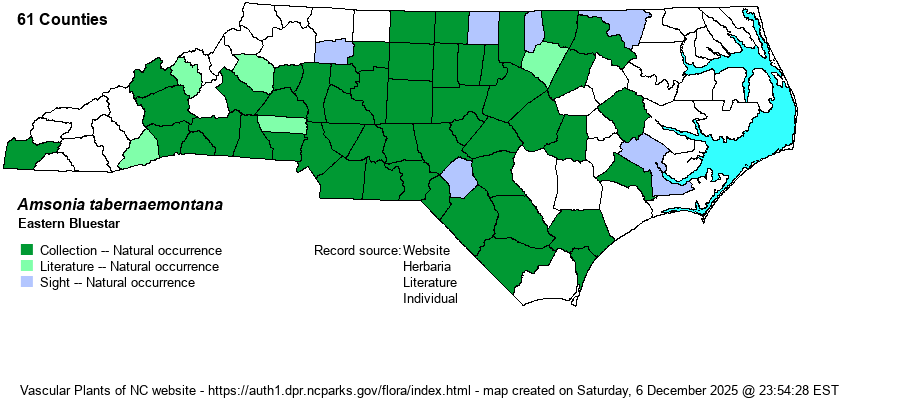| Author | Walter | |
| Distribution | Essentially throughout the Piedmont and western half of the Coastal Plain, but of spotty occurrence in the central Coastal Plain. Also of local occurrence in the central and southern Mountains. Seemingly absent in the eastern Coastal Plain and the northern Mountains.
This is a Southern species, ranging north only to central VA in the East, but farther to the north westward, reaching northern IL and KS. Ranges south to northern FL and central TX. | |
| Abundance | Fairly common to common in the Piedmont, except for the northwestern portions, where rare. Fairly common in the western Coastal Plain, including the Sandhills, but less numerous eastward; rare to locally uncommon in central sections, and seemingly very rare to absent east of Northampton, Pitt, and Craven counties. Rare to locally uncommon in the lowest elevations of the central and southern Mountains. | |
| Habitat | This species is found in rich hardwood to mixed forests, mainly on lower slopes and in bottomland forests. It occurs mainly in Mesic Mixed Hardwood Forests, but can occur in Basic Mesic Forests. It normally grows in full shade. |
| Phenology | Blooms mainly in April, and fruits in August and September. | |
| Identification | This is an herbaceous, erect species growing singly or several stems in a clump, to 1-2 feet tall, with some short branching from upper nodes. The leaves are alternate, fairly standard in shape and size -- lanceolate to narrowly ovate, about 3-4 inches long and about 1-1.5 inches wide. The inflorescence is rather large and showy, being terminal on branches and several inches across in a ball shape. Each of the light blue flowers has a slender tube and five narrow and spreading petals in a star shape, being about 4/5-inch across. Normally a handful of plants grows together in a clump, and thus when in bloom in the shade of the forest creates a most conspicuous and pleasing light blue spectacle, as most spring forest wildflowers are white or yellow in color. The sap on the plants is milky white, and thus if you are in doubt of the identity of a vegetative plant, break off a leaf at the base and see if it has the white sap. In late summer and fall, paired very slender pods form, and these are strikingly erect at the tips of branches. Each pod is up to 4 inches long. This is a moderately easily found species on forested slopes in most of the Piedmont and upper Coastal Plain, oftentimes the only plant in bloom that has a striking light blue flower color. | |
| Taxonomic Comments | There are several varieties of the species. RAB (1968) indicated that both the nominate form var. tabernaemontana and var. salicifolia occurred in NC. Weakley (2018) feels that these two varieties are similar enough for him not to consider var. salicifolia as a good taxon; but in 2020 he raised salicifolia to full species status without any data or clarification. In an examination of specimens of both taxa from throughout their ranges, Sorrie found that, while extremes could be separated, most plants showed mixed characters.
| |
| Other Common Name(s) | Blue Dogbane. The species is often simply call just "Bluestar" or "Blue-star", but as there are a few other species in the genus, and as the genus has the group common name of "bluestar", a modifier name is necessary, and many references use Eastern Bluestar. | |
| State Rank | S5 | |
| Global Rank | G5 | |
| State Status | | |
| US Status | | |
| USACE-agcp | FACW link |
| USACE-emp | FAC link |

